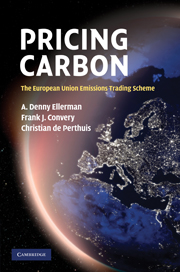Book contents
- Frontmatter
- Contents
- List of figures
- List of tables
- List of boxes
- List of appendices
- Frequently used abbreviations
- Preface
- 1 Introduction
- 2 Origins and development of the EU ETS
- 3 Allowance allocation
- 4 Effects of free allocation
- 5 Market development
- 6 Emissions abatement
- 7 Industrial competitiveness
- 8 Costs
- 9 Linkage and global implications
- 10 Conclusions
- Annex: The interaction between the EU ETS and European electricity markets
- Appendix A Sequence of events in the development of the EU ETS and Linking Directives
- Appendix B Data tables
- Bibliography
- Index
3 - Allowance allocation
Published online by Cambridge University Press: 05 July 2011
- Frontmatter
- Contents
- List of figures
- List of tables
- List of boxes
- List of appendices
- Frequently used abbreviations
- Preface
- 1 Introduction
- 2 Origins and development of the EU ETS
- 3 Allowance allocation
- 4 Effects of free allocation
- 5 Market development
- 6 Emissions abatement
- 7 Industrial competitiveness
- 8 Costs
- 9 Linkage and global implications
- 10 Conclusions
- Annex: The interaction between the EU ETS and European electricity markets
- Appendix A Sequence of events in the development of the EU ETS and Linking Directives
- Appendix B Data tables
- Bibliography
- Index
Summary
Introduction
A unique feature of cap-and-trade systems
Cap-and-trade systems operate through the creation and distribution of tradable rights to emit, usually called allowances, to installations. Since a constraining cap creates a scarcity rent, these allowances have value, and there are many claimants for them, not least the owners of installations required to surrender allowances equal to their emissions. The distribution of these rights, usually for free, is what is called allocation, and it is the unique feature of cap-and-trade systems.
Allocation is often portrayed as contentious and sordid, but it should be remembered that similar rights, rents and value are created by any system that effectively constrains emissions. An emissions tax is relatively straightforward. It creates a fixed price on emissions, instead of a fixed quantity limit, and the right to emit is acquired by paying the tax. The government is typically the recipient of the tax revenues, although cases exist in which the revenues are returned to emitters, such as the NOx (nitrogen oxides) tax in Sweden (Millock and Sterner 2004). ‘Command-and-control’ approaches are more common and less transparent, but they create the same rights and rents. Firms acquire implicit rights to emit by meeting the prescribed regulatory standard, or whatever derogations may be granted. The value created by the constraint is conveyed to facilities meeting the new standard through the increase in the price of output due to the new regulatory requirement, which often places more demanding standards on new entrants.
- Type
- Chapter
- Information
- Pricing CarbonThe European Union Emissions Trading Scheme, pp. 32 - 84Publisher: Cambridge University PressPrint publication year: 2010



